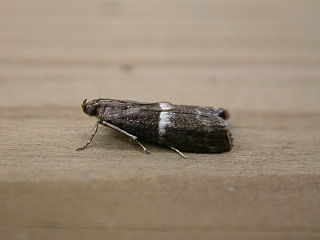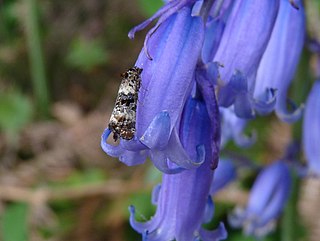
Nepenthes stenophylla, or the narrow-leaved pitcher-plant, is a tropical pitcher plant endemic to Borneo. The species produces attractive funnel-shaped pitchers up to 25 cm high. It is listed as Least Concern on the IUCN Red List. Nepenthes stenophylla belongs to the loosely defined "N. maxima complex", which also includes, among other species, N. boschiana, N. chaniana, N. epiphytica, N. eymae, N. faizaliana, N. fusca, N. klossii, N. maxima, N. platychila, and N. vogelii.

Mnesarchaea is a genus of "New Zealand primitive moths" in the family Mnesarchaeidae. This genus is endemic to New Zealand.

The twait shad or twaite shad is a species of fish in the family Clupeidae. It is found in the eastern Atlantic Ocean and the Mediterranean Sea and is an anadromous fish which lives in the sea but migrates into fresh water to spawn. In appearance it resembles an Atlantic herring but has a row of six to ten distinctive spots on its silvery flanks. They become mature when three or more years old and migrate to estuaries, later swimming up rivers to spawn. Populations of this fish have declined due to overfishing, pollution and habitat destruction. Conservation of this species is covered by Appendix III of the Bern Convention and Appendix II and V of the European Community Habitats Directive.

Aglossa pinguinalis, the large tabby or grease moth, is a moth in the subfamily Pyralinae. The species was first described by Carl Linnaeus in his 1758 10th edition of Systema Naturae.

Anthophila fabriciana, also known as the common nettle-tap, is a moth of the family Choreutidae first described in 1767 by Carl Linnaeus. The moth can be found flying around stinging nettles during the day.

Tathorhynchus is a monotypic moth genus in the family Erebidae erected by George Hampson in 1894. Its only species, Tathorhynchus exsiccata, the Levant blackneck or double-spotted snout, was first described by Julius Lederer in 1855. The nominate form is found on the Canary Islands and in North Africa, tropical Asia and tropical Africa. It has been introduced in Dominica and Argentina. Subspecies Tathorhynchus exsiccata fallax is found in the northern half of Australia, as well as Norfolk Island and New Zealand.

Acronicta fallax, the green marvel, is a moth of the family Noctuidae. The species was first described by Gottlieb August Wilhelm Herrich-Schäffer in 1854. It is found in most of North America, from Ontario, Quebec, New Brunswick, Nova Scotia, Newfoundland and Labrador and Manitoba south to Arizona and Florida.

Cosmopterix schmidiella is a moth of the family Cosmopterigidae. It is found from most of Great Britain to Romania, and from Japan through central Russia to the Iberian Peninsula. It is believed to be extinct in Britain.

Elegia similella is a moth of the family Pyralidae. It was described by Johann Leopold Theodor Friedrich Zincken in 1818 and is known from most of Europe. The habitat consists of old, mature woodland and parkland.
Depressaria douglasella is a moth of the family Depressariidae. It is found in most of Europe.

Caryocolum proxima is a moth of the family Gelechiidae. It is found in most of Europe. It is also known from North America.

Elegia is a genus of snout moths. It was described by Émile Louis Ragonot in 1887.
Elegia inconspicuella is a species of snout moth in the genus Elegia. It was described by Ragonot in 1888. It is found in South Africa.
Elegia miserabilis is a species of moth of the family Pyralidae. It was described by Embrik Strand in 1919 and is found in Taiwan.
Elegia omichleuta is a species of moth of the family Pyralidae. It was described by Edward Meyrick in 1934 and is found in Sudan.
Elegia southi is a species of moth of the family Pyralidae. It was described by Reginald James West in 1932 and is found in Taiwan.

Mnesarchaea fallax is a species of primitive moth in the family Mnesarchaeidae. It is endemic to New Zealand. This species is found in the Taranaki, Taupo, Nelson and Buller regions. It lives in a variety of habitats such as beech forest clearings, native podocarp forest, red tussock grasslands as well as in flax wetlands and at higher altitudes of up to 1300m. Much of the life history of this species is unknown and as at 2021 the host plants of this species have yet to be confirmed. The adult moths are on the wing from October to December. This species is classified as "Not Threatened" by the Department of Conservation.

Chionodes distinctella, the eastern groundling, is a moth of the family Gelechiidae. It is found in almost all of Europe, as well as most of Russia, Kazakhstan, Central Asia and North Africa. The habitat consists of dry, rocky heath and meadows and the verges and rough pastures.

Gelechia turpella, the grand groundling, is a moth of the family Gelechiidae. It is widely distributed in Europe. Outside of Europe, it is found from the Caucasus to Siberia and the Russian Far East. The habitat consists of woodlands and parks.

Hysterophora maculosana, the bluebell conch, is a species of moth of the family Tortricidae. It is found from most of Europe, east to the Crimea, Asia Minor and the Palestinian territories. The habitat consists of woodland areas.














